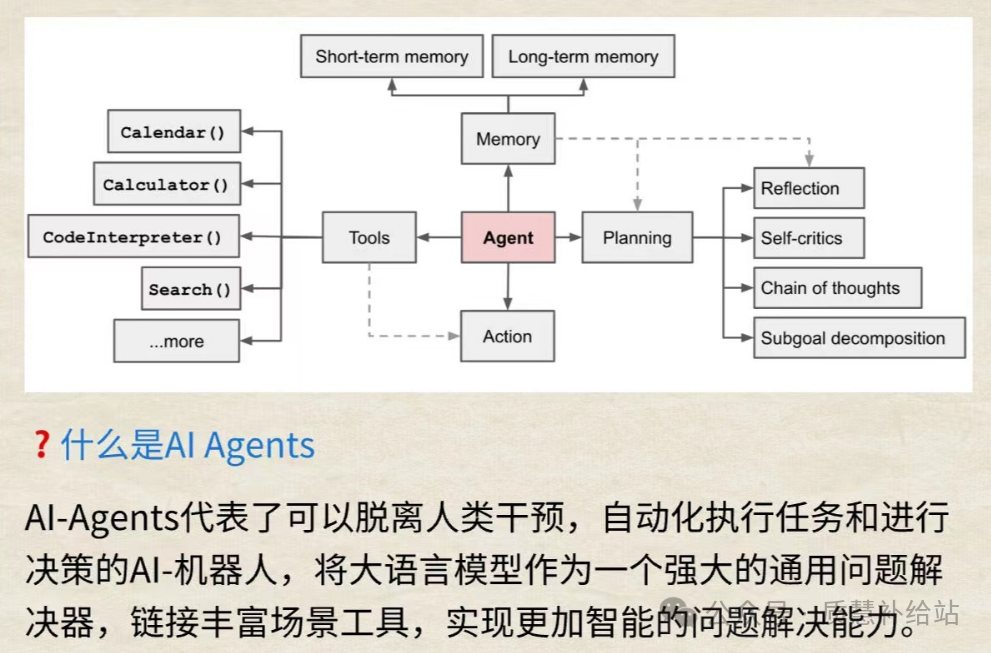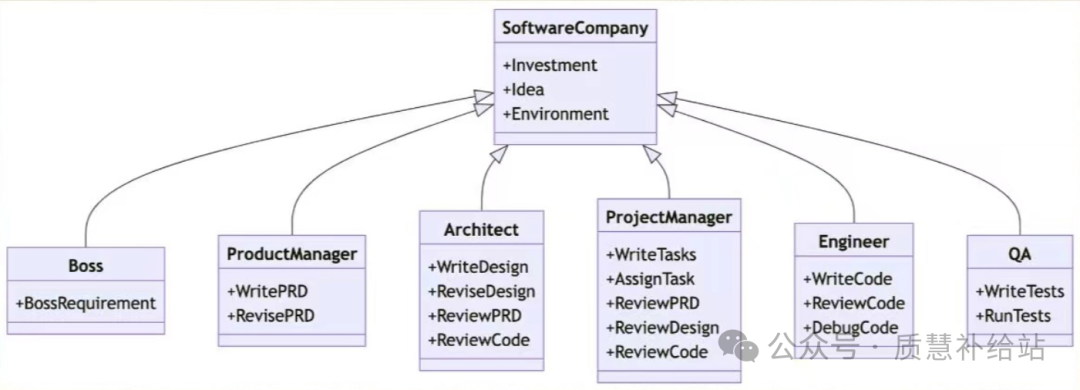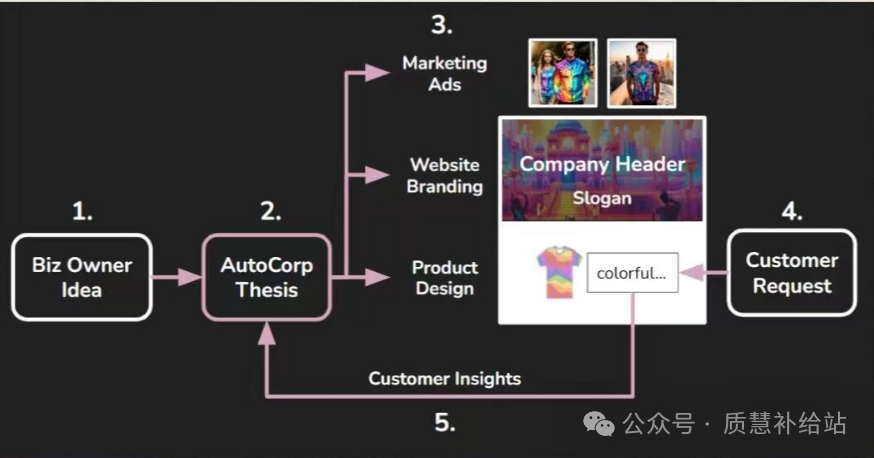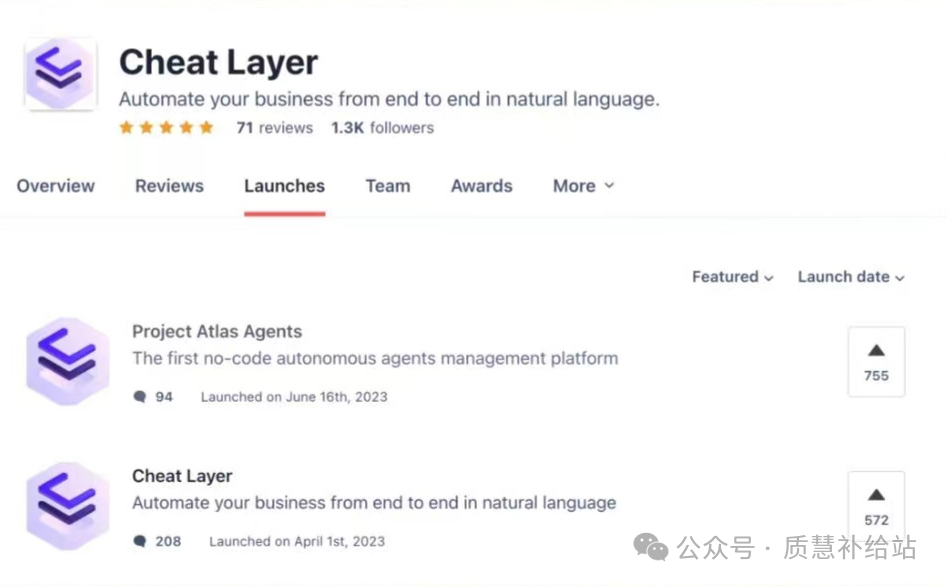 Artificial Intelligence (AI) is spreading at an astonishing rate, like wildfire across the grasslands. In this field, Large Language Models (LLM) have emerged as a focal point of attention. Meanwhile, the concept of AI Agent is rising like a new star, sparking widespread discussion throughout the tech community and society at large. Industry experts and practitioners generally believe that among the many branches of AIGC technology, AI Agents are undoubtedly the key technology that will have the most profound impact on work and life. Some even suggest that AI Agents may be the key pathway to achieving Artificial General Intelligence (AGI).01 What is an AI AgentAn AI Agent is an intelligent entity capable of perceiving its environment, making choices, and executing corresponding actions. Its main distinction from traditional AI lies in its ability to think independently and utilize various tools to gradually achieve set goals. Imagine an AI Agent as a robotic engineer; on a factory production line, it can not only remember where each component should be placed but also plan the most efficient assembly strategy and accurately use robotic arms to assemble products. The four core elements that simulate human intelligence in an AI Agent are: Memory, Planning, Large Language Models and Tool Use. These four elements play a crucial role in mimicking human intelligent behavior.02 Technical Composition of AI Agents Memory Memory is the fundamental skill that AI Agents use to store and retrieve information, which is essential for mimicking human learning and experience accumulation. In AI systems, memory can be long-term stored data, such as historical records in a database, or short-term memory, like temporary information for current tasks. Just as in knowledge management systems, memory allows AI to utilize past data to enhance decision-making and action efficiency. Planning Ability Planning ability is the capacity of an AI to formulate and implement multi-step strategies to achieve goals. This includes defining task objectives, evaluating possible action plans, and determining the sequence of action steps. Planning is particularly important when handling complex tasks and adapting to changing environments, such as in automated warehouse sorting systems, which need to plan the optimal path for accessing and transporting goods. Large Language Models, such as GPT-4 and ChatGLM, are core technologies in AI systems for understanding and generating natural language. These models learn the structure and usage of language by analyzing vast amounts of text data, enabling AI to possess efficient language understanding, creation, and translation capabilities. They play a key role in human-computer interaction and information processing, as seen in customer service robots that use language models to understand and respond to customer inquiries. Tool Use is the ability of AI to utilize external tools or devices to complete specific tasks. In human behavior, tool use is a hallmark of intelligence and creativity. In the AI field, tool use may involve software tools, such as algorithms for data analysis, or hardware tools, like robots using precision welding work.03 The Construction Process of AI Agents Designing and cultivating an AI Agent is a comprehensive process that employs machine learning and artificial intelligence technologies, involving methods such as reinforcement learning and deep learning. Through interaction and feedback with the environment, AI Agents can continuously improve their performance and efficiency to complete tasks more accurately. Key steps in constructing an AI Agent include:Defining Tasks and Objectives: First, clarify the specific tasks and objectives the AI Agent is to solve, such as industrial automation agents, office RPA, image automatic recognition, etc.Defining Inputs and Outputs: Determine the input information required by the AI Agent and the expected output behavior; inputs may include sensor data, text, images, etc., while outputs may be decisions, actions, or generated text or images.Data Collection and Preparation: Collect and prepare datasets for training the AI Agent; these data should cover inputs related to the task and the corresponding correct outputs or reward signals. Data sources can be real-world observations or obtained through simulated environments.Selecting Appropriate Algorithms and Models: Choose suitable algorithms and models for training the AI Agent based on task characteristics, which may include deep neural networks, decision trees, Gaussian processes, and various other techniques.Training the AI Agent: Train the AI Agent using the carefully prepared dataset and selected algorithms. This process may require multiple iterations and optimizations, adjusting model parameters and algorithms to enhance the AI Agent’s performance.Evaluation and Tuning: Evaluate the trained AI Agent and tune it based on performance. Evaluation can use test datasets or be conducted through simulated tests in real environments. Based on evaluation results, adjustments may be needed for algorithms, models, or training processes to improve the AI Agent’s performance.Deployment and Application: The trained and evaluated AI Agent can be deployed in real application scenarios. This may involve integrating the Agent into hardware devices, software systems, or network services to solve practical problems, such as controlling temperature and lighting in smart home systems. It is important to note that constructing an AI Agent is a complex process involving multiple stages, including task requirement analysis, data preparation, algorithm selection, training, and evaluation.Additionally, the development of AI Agents typically requires specialized knowledge and technical support, often necessitating interdisciplinary team collaboration or the involvement of professionals.04 Examples of AI Agents1. Auto-GPTAuto-GPT is one of the most well-known open-source projects, aimed at making GPT-4 fully autonomous. In simple terms, Auto-GPT can break down task requirements into steps and automatically refine the execution steps to achieve the final task result, fully automating the process. In layman’s terms, Auto-GPT completes tasks through a process of “self-questioning and self-answering,” without requiring human prompts.
Artificial Intelligence (AI) is spreading at an astonishing rate, like wildfire across the grasslands. In this field, Large Language Models (LLM) have emerged as a focal point of attention. Meanwhile, the concept of AI Agent is rising like a new star, sparking widespread discussion throughout the tech community and society at large. Industry experts and practitioners generally believe that among the many branches of AIGC technology, AI Agents are undoubtedly the key technology that will have the most profound impact on work and life. Some even suggest that AI Agents may be the key pathway to achieving Artificial General Intelligence (AGI).01 What is an AI AgentAn AI Agent is an intelligent entity capable of perceiving its environment, making choices, and executing corresponding actions. Its main distinction from traditional AI lies in its ability to think independently and utilize various tools to gradually achieve set goals. Imagine an AI Agent as a robotic engineer; on a factory production line, it can not only remember where each component should be placed but also plan the most efficient assembly strategy and accurately use robotic arms to assemble products. The four core elements that simulate human intelligence in an AI Agent are: Memory, Planning, Large Language Models and Tool Use. These four elements play a crucial role in mimicking human intelligent behavior.02 Technical Composition of AI Agents Memory Memory is the fundamental skill that AI Agents use to store and retrieve information, which is essential for mimicking human learning and experience accumulation. In AI systems, memory can be long-term stored data, such as historical records in a database, or short-term memory, like temporary information for current tasks. Just as in knowledge management systems, memory allows AI to utilize past data to enhance decision-making and action efficiency. Planning Ability Planning ability is the capacity of an AI to formulate and implement multi-step strategies to achieve goals. This includes defining task objectives, evaluating possible action plans, and determining the sequence of action steps. Planning is particularly important when handling complex tasks and adapting to changing environments, such as in automated warehouse sorting systems, which need to plan the optimal path for accessing and transporting goods. Large Language Models, such as GPT-4 and ChatGLM, are core technologies in AI systems for understanding and generating natural language. These models learn the structure and usage of language by analyzing vast amounts of text data, enabling AI to possess efficient language understanding, creation, and translation capabilities. They play a key role in human-computer interaction and information processing, as seen in customer service robots that use language models to understand and respond to customer inquiries. Tool Use is the ability of AI to utilize external tools or devices to complete specific tasks. In human behavior, tool use is a hallmark of intelligence and creativity. In the AI field, tool use may involve software tools, such as algorithms for data analysis, or hardware tools, like robots using precision welding work.03 The Construction Process of AI Agents Designing and cultivating an AI Agent is a comprehensive process that employs machine learning and artificial intelligence technologies, involving methods such as reinforcement learning and deep learning. Through interaction and feedback with the environment, AI Agents can continuously improve their performance and efficiency to complete tasks more accurately. Key steps in constructing an AI Agent include:Defining Tasks and Objectives: First, clarify the specific tasks and objectives the AI Agent is to solve, such as industrial automation agents, office RPA, image automatic recognition, etc.Defining Inputs and Outputs: Determine the input information required by the AI Agent and the expected output behavior; inputs may include sensor data, text, images, etc., while outputs may be decisions, actions, or generated text or images.Data Collection and Preparation: Collect and prepare datasets for training the AI Agent; these data should cover inputs related to the task and the corresponding correct outputs or reward signals. Data sources can be real-world observations or obtained through simulated environments.Selecting Appropriate Algorithms and Models: Choose suitable algorithms and models for training the AI Agent based on task characteristics, which may include deep neural networks, decision trees, Gaussian processes, and various other techniques.Training the AI Agent: Train the AI Agent using the carefully prepared dataset and selected algorithms. This process may require multiple iterations and optimizations, adjusting model parameters and algorithms to enhance the AI Agent’s performance.Evaluation and Tuning: Evaluate the trained AI Agent and tune it based on performance. Evaluation can use test datasets or be conducted through simulated tests in real environments. Based on evaluation results, adjustments may be needed for algorithms, models, or training processes to improve the AI Agent’s performance.Deployment and Application: The trained and evaluated AI Agent can be deployed in real application scenarios. This may involve integrating the Agent into hardware devices, software systems, or network services to solve practical problems, such as controlling temperature and lighting in smart home systems. It is important to note that constructing an AI Agent is a complex process involving multiple stages, including task requirement analysis, data preparation, algorithm selection, training, and evaluation.Additionally, the development of AI Agents typically requires specialized knowledge and technical support, often necessitating interdisciplinary team collaboration or the involvement of professionals.04 Examples of AI Agents1. Auto-GPTAuto-GPT is one of the most well-known open-source projects, aimed at making GPT-4 fully autonomous. In simple terms, Auto-GPT can break down task requirements into steps and automatically refine the execution steps to achieve the final task result, fully automating the process. In layman’s terms, Auto-GPT completes tasks through a process of “self-questioning and self-answering,” without requiring human prompts.

Project Address:
https://github.com/Significant-Gravitas/Auto-GPT
2. BabyAGI
BabyAGI is a system capable of automatically creating, sorting, and executing tasks. It utilizes natural language processing technology to create new tasks based on preset goals and stores task results in a database for future use. In fact, BabyAGI is a script written in Python. This script completes the following steps through an infinite loop:

Project Address:
https://github.com/yoheinakajima/babyagi
3. MetaGPT
Released in July last year, MetaGPT is a brand new AI Agent project that provides an automated agent framework focused on software development based on GPT-4. It can be understood as a small team equipped with a product manager, system designer, and programmer, capable of directly generating final code projects based on original requirements. Meta GPT includes product managers/architects/project managers/engineers, providing a complete process for a software company with carefully coordinated SOPs.

Project Address:
https://github.com/geekan/MetaGPT
4. NexusGPT
This platform is based on the LangChain framework, using the GPT-3.5 API and Chroma embedded database, claiming to be the world’s first AI freelancer platform, currently boasting over 800 AI agents with various skills. NexusGPT represents a future business model: the way humans hire AI Agents. This new model will also give rise to payment methods based on token consumption, profoundly impacting the human employment market.

Website:
https://app.gpt.nexus/App/Chats/New
5. AutoCorp
AutoCorp is a fully autonomous brand marketing company. It can automatically create brand advertisements and product designs for direct sales T-shirt companies. When customers present new consumption demands, AutoCorp updates themes and generates new design assets, continuously iterating towards better business directions. AutoCorp’s goals align closely with those of DAOs (Decentralized Autonomous Organizations), representing the future direction of DAO business development.

Website:
https://www.autocorp.ai/
6. Transformer Agent
Transformer Agents are an extension of the Transformer framework, adding natural language-based APIs. Huggingface provides tools and designs an agent to interpret natural language and utilize these tools. The design of this system is scalable, allowing human intelligence to be concentrated in an AI model library and providing services for complex problems across various industries through agents. This imaginative approach fills people with anticipation for the future.

Website:
https://huggingface.co/docs/transformers/transformersagents
7. Cheat Layer
“Automate your business using natural language” is the brand slogan of Cheat Layer. Cheat Layer operates as a Google Chrome extension, automating operations across entire web pages using natural language. In fact, most routine operations we perform on the web can be automated. It solves seemingly impossible business problems through a custom-trained GPT-4 machine learning model, acting as an AI software engineer for each user.

Website:
https://cheatlayer.com/
8. GPT Researcher
It is an autonomous agent based on GPT, capable of conducting comprehensive online research on any given topic. The architecture of GPT Researcher includes two agents: “Planner” and “Executor.” The Planner generates research questions, while the Executor searches for relevant information based on the questions generated by the Planner. Finally, the Planner filters and summarizes all relevant information, generating a research report.

Project Address: https://github.com/assafelovic/gpt-researcher—— E N D ——
Long
Press
Related
Notes
Quality Wisdom Supply Station
ID : AI_Supply_Station
Exploring AIGC practices together
